Guillaume Arbod
Sky-image-based solar forecasting using deep learning with multi-location data: training models locally, globally or via transfer learning?
Nov 03, 2022Abstract:Solar forecasting from ground-based sky images using deep learning models has shown great promise in reducing the uncertainty in solar power generation. One of the biggest challenges for training deep learning models is the availability of labeled datasets. With more and more sky image datasets open sourced in recent years, the development of accurate and reliable solar forecasting methods has seen a huge growth in potential. In this study, we explore three different training strategies for deep-learning-based solar forecasting models by leveraging three heterogeneous datasets collected around the world with drastically different climate patterns. Specifically, we compare the performance of models trained individually based on local datasets (local models) and models trained jointly based on the fusion of multiple datasets from different locations (global models), and we further examine the knowledge transfer from pre-trained solar forecasting models to a new dataset of interest (transfer learning models). The results suggest that the local models work well when deployed locally, but significant errors are observed for the scale of the prediction when applied offsite. The global model can adapt well to individual locations, while the possible increase in training efforts need to be taken into account. Pre-training models on a large and diversified source dataset and transferring to a local target dataset generally achieves superior performance over the other two training strategies. Transfer learning brings the most benefits when there are limited local data. With 80% less training data, it can achieve 1% improvement over the local baseline model trained using the entire dataset. Therefore, we call on the efforts from the solar forecasting community to contribute to a global dataset containing a massive amount of imagery and displaying diversified samples with a range of sky conditions.
Omnivision forecasting: combining satellite observations with sky images for improved intra-hour solar energy predictions
Jun 07, 2022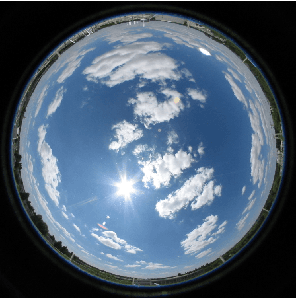
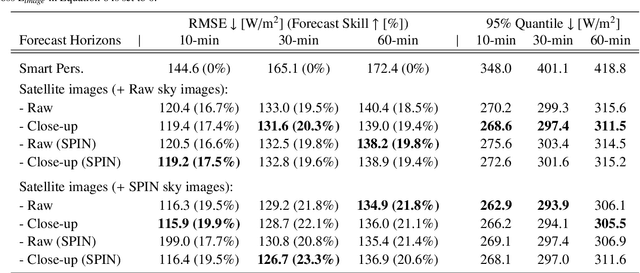


Abstract:Integration of intermittent renewable energy sources into electric grids in large proportions is challenging. A well-established approach aimed at addressing this difficulty involves the anticipation of the upcoming energy supply variability to adapt the response of the grid. In solar energy, short-term changes in electricity production caused by occluding clouds can be predicted at different time scales from all-sky cameras (up to 30-min ahead) and satellite observations (up to 6h ahead). In this study, we integrate these two complementary points of view on the cloud cover in a single machine learning framework to improve intra-hour (up to 60-min ahead) irradiance forecasting. Both deterministic and probabilistic predictions are evaluated in different weather conditions (clear-sky, cloudy, overcast) and with different input configurations (sky images, satellite observations and/or past irradiance values). Our results show that the hybrid model benefits predictions in clear-sky conditions and improves longer-term forecasting. This study lays the groundwork for future novel approaches of combining sky images and satellite observations in a single learning framework to advance solar nowcasting.
SPIN: Simplifying Polar Invariance for Neural networks Application to vision-based irradiance forecasting
Nov 29, 2021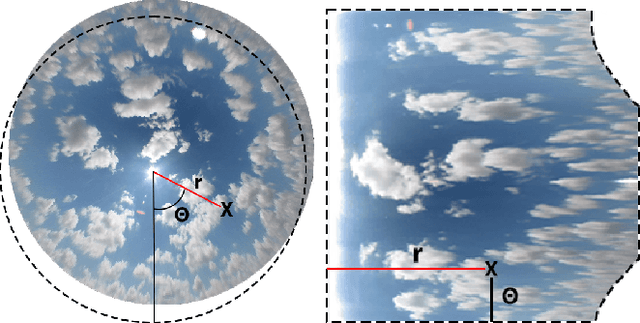
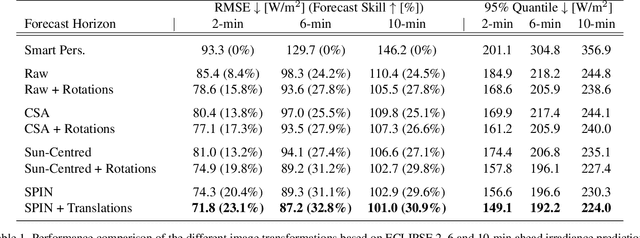

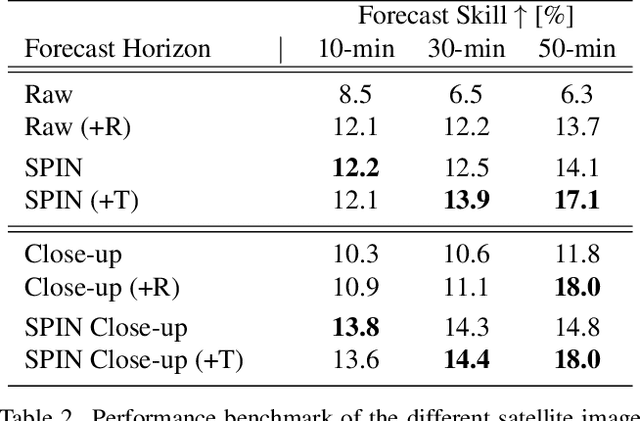
Abstract:Translational invariance induced by pooling operations is an inherent property of convolutional neural networks, which facilitates numerous computer vision tasks such as classification. Yet to leverage rotational invariant tasks, convolutional architectures require specific rotational invariant layers or extensive data augmentation to learn from diverse rotated versions of a given spatial configuration. Unwrapping the image into its polar coordinates provides a more explicit representation to train a convolutional architecture as the rotational invariance becomes translational, hence the visually distinct but otherwise equivalent rotated versions of a given scene can be learnt from a single image. We show with two common vision-based solar irradiance forecasting challenges (i.e. using ground-taken sky images or satellite images), that this preprocessing step significantly improves prediction results by standardising the scene representation, while decreasing training time by a factor of 4 compared to augmenting data with rotations. In addition, this transformation magnifies the area surrounding the centre of the rotation, leading to more accurate short-term irradiance predictions.
ECLIPSE : Envisioning Cloud Induced Perturbations in Solar Energy
Apr 26, 2021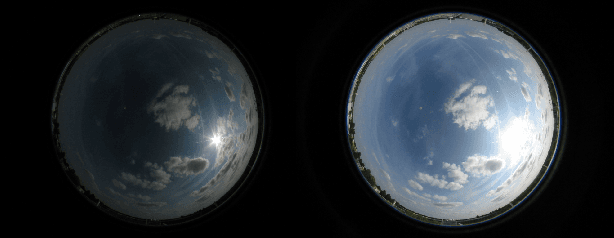
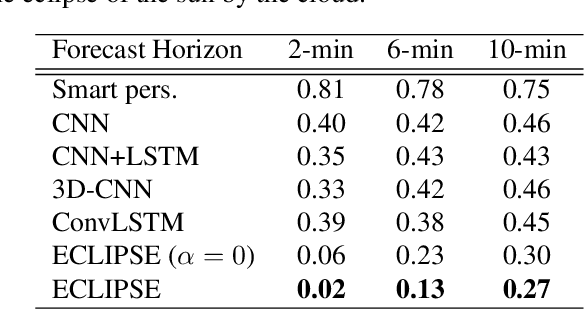
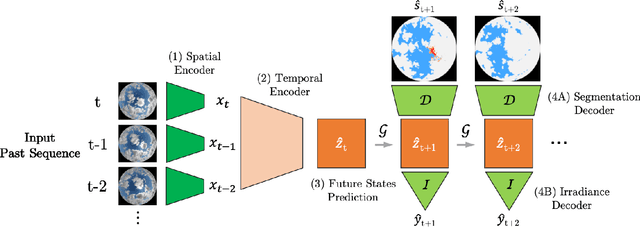

Abstract:Efficient integration of solar energy into the electricity mix depends on a reliable anticipation of its intermittency. A promising approach to forecast the temporal variability of solar irradiance resulting from the cloud cover dynamics, is based on the analysis of sequences of ground-taken sky images. Despite encouraging results, a recurrent limitation of current Deep Learning approaches lies in the ubiquitous tendency of reacting to past observations rather than actively anticipating future events. This leads to a systematic temporal lag and little ability to predict sudden events. To address this challenge, we introduce ECLIPSE, a spatio-temporal neural network architecture that models cloud motion from sky images to predict both future segmented images and corresponding irradiance levels. We show that ECLIPSE anticipates critical events and considerably reduces temporal delay while generating visually realistic futures.
Benchmarking of Deep Learning Irradiance Forecasting Models from Sky Images -- an in-depth Analysis
Feb 02, 2021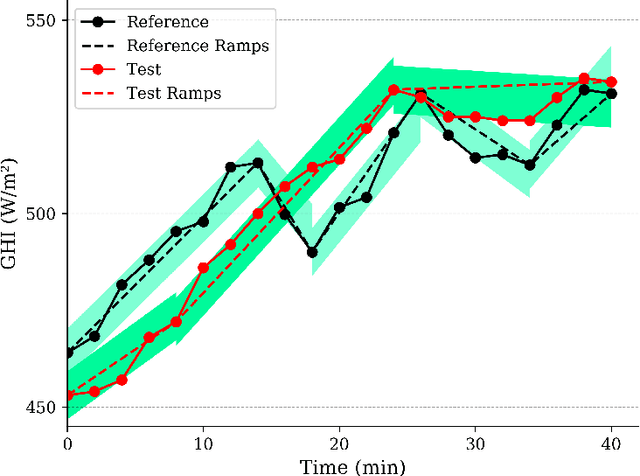

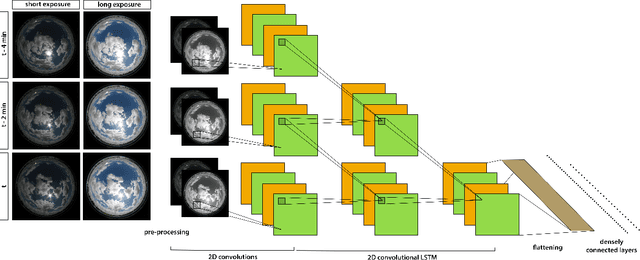
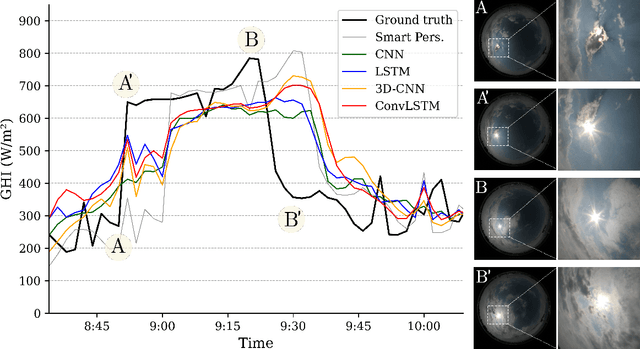
Abstract:A number of industrial applications, such as smart grids, power plant operation, hybrid system management or energy trading, could benefit from improved short-term solar forecasting, addressing the intermittent energy production from solar panels. However, current approaches to modelling the cloud cover dynamics from sky images still lack precision regarding the spatial configuration of clouds, their temporal dynamics and physical interactions with solar radiation. Benefiting from a growing number of large datasets, data driven methods are being developed to address these limitations with promising results. In this study, we compare four commonly used Deep Learning architectures trained to forecast solar irradiance from sequences of hemispherical sky images and exogenous variables. To assess the relative performance of each model, we used the Forecast Skill metric based on the smart persistence model, as well as ramp and time distortion metrics. The results show that encoding spatiotemporal aspects of the sequence of sky images greatly improved the predictions with 10 min ahead Forecast Skill reaching 20.4% on the test year. However, based on the experimental data, we conclude that, with a common setup, Deep Learning models tend to behave just as a 'very smart persistence model', temporally aligned with the persistence model while mitigating its most penalising errors. Thus, despite being captured by the sky cameras, models often miss fundamental events causing large irradiance changes such as clouds obscuring the sun. We hope that our work will contribute to a shift of this approach to irradiance forecasting, from reactive to anticipatory.
 Add to Chrome
Add to Chrome Add to Firefox
Add to Firefox Add to Edge
Add to Edge